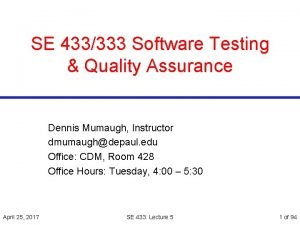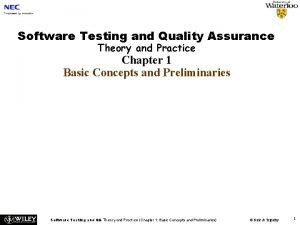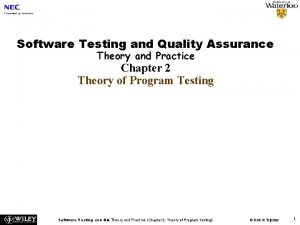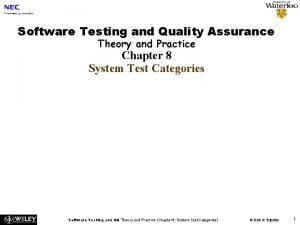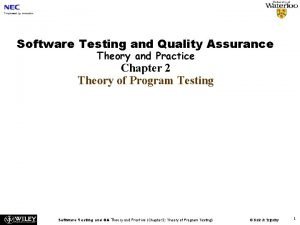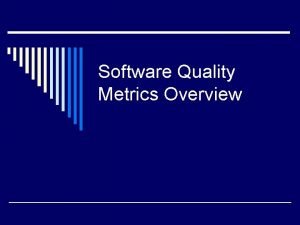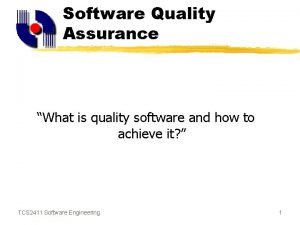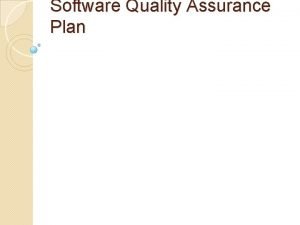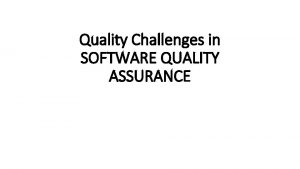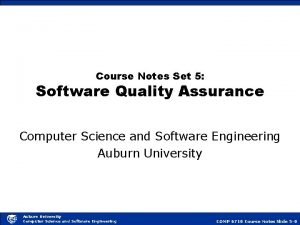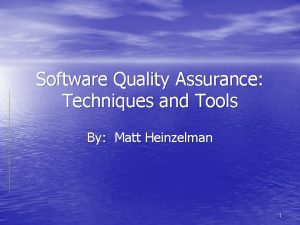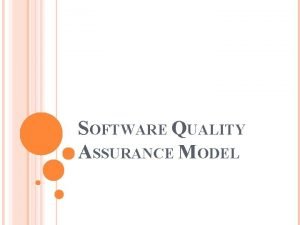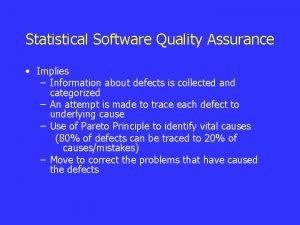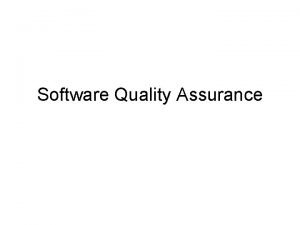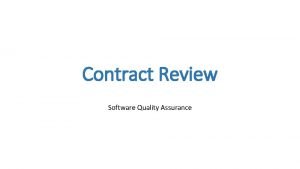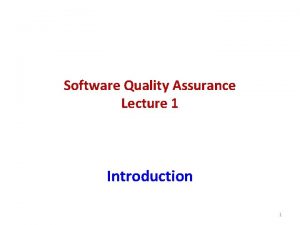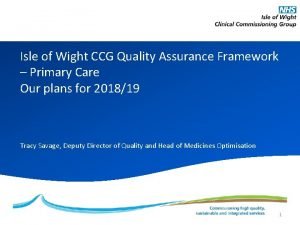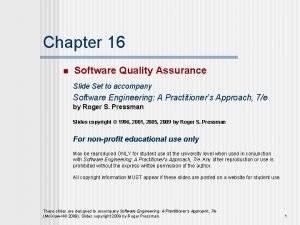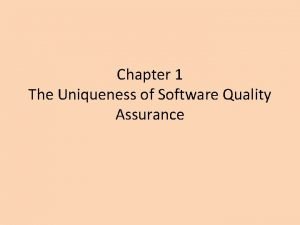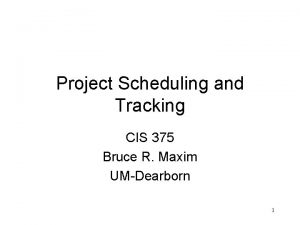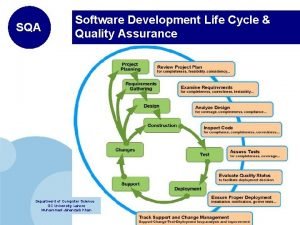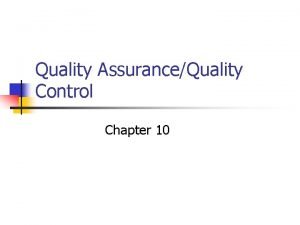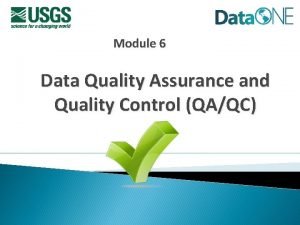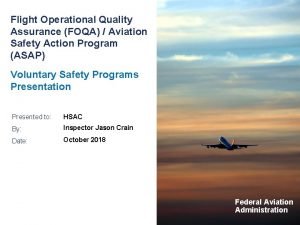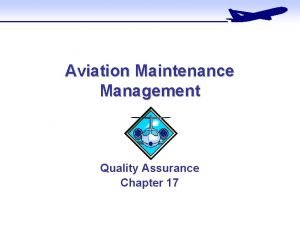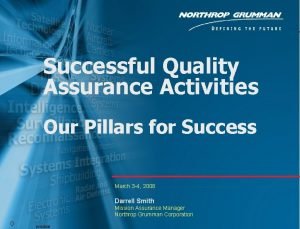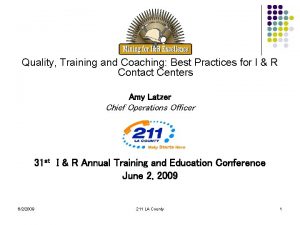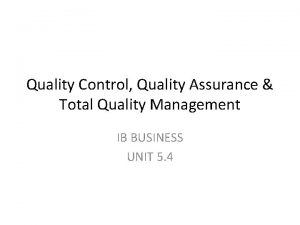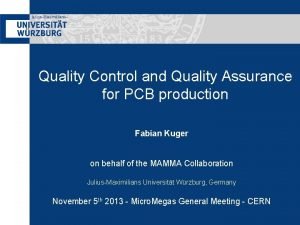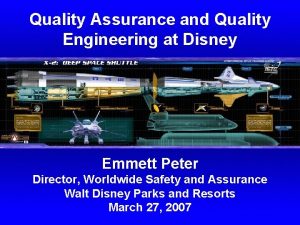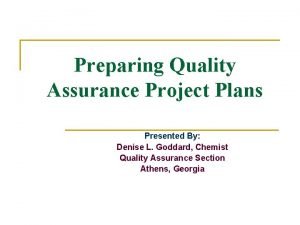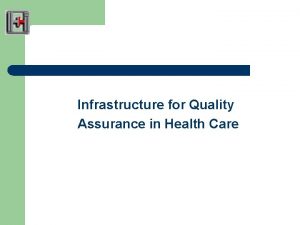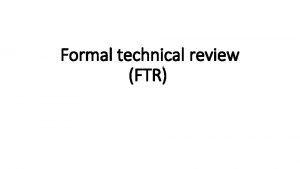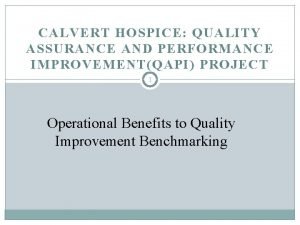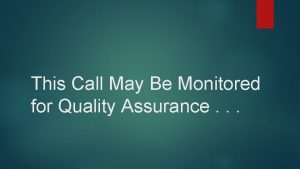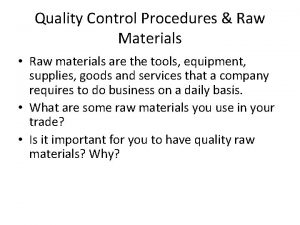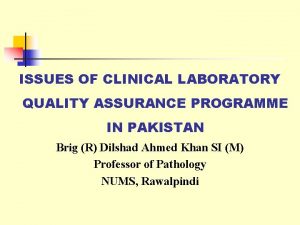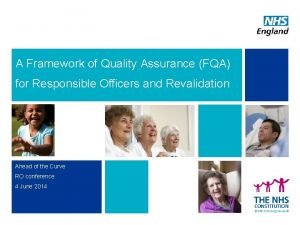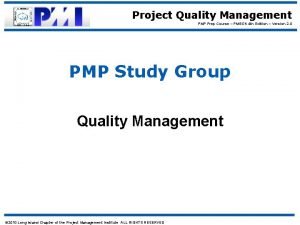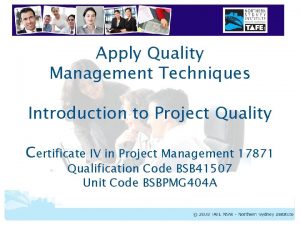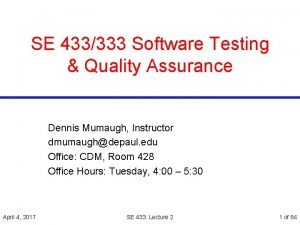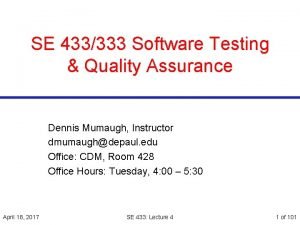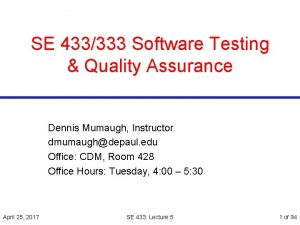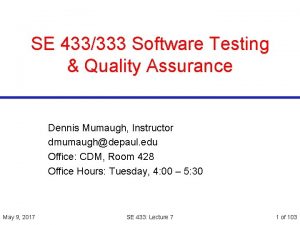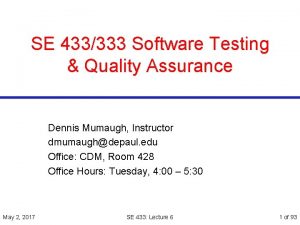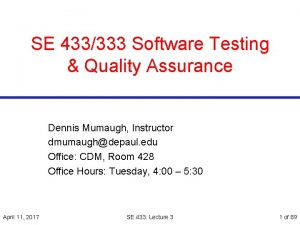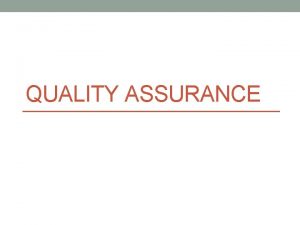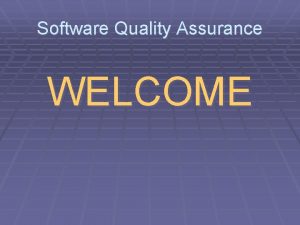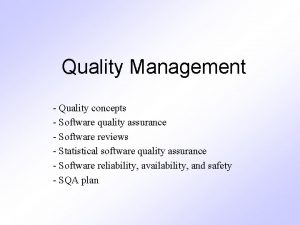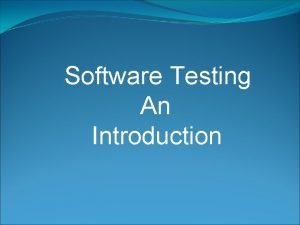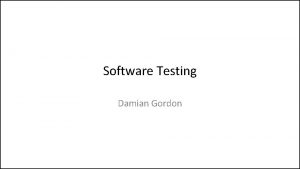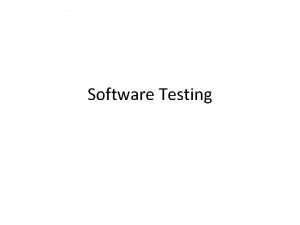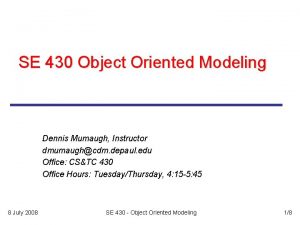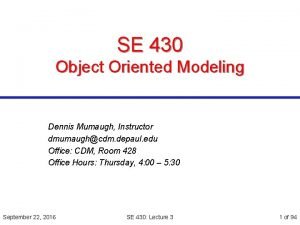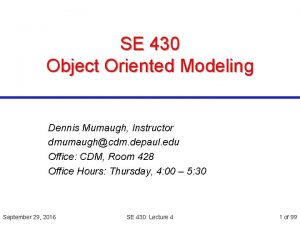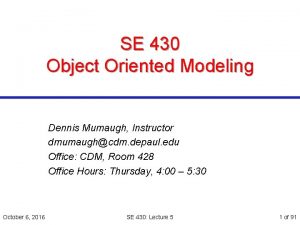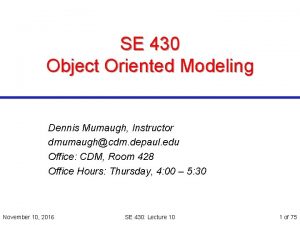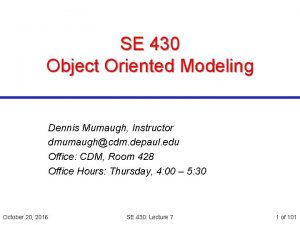SE 433333 Software Testing Quality Assurance Dennis Mumaugh























































































- Slides: 87

SE 433/333 Software Testing & Quality Assurance Dennis Mumaugh, Instructor dmumaugh@depaul. edu Office: CDM, Room 428 Office Hours: Tuesday, 4: 00 – 5: 30 May 30, 2017 SE 433: Lecture 10 1 of 87

Administrivia § Comments and feedback § Assignment 1 -8 solutions are posted, Assignment 9 on Wednesday § Assignments and exams: Ø Assignment 9: Due May 30 Ø Final exam: June 1 -7 Ø Take home exam/paper: June 6 [For SE 433 students only] § Final examination Ø Will be on Desire 2 Learn. Ø June 1 to June 7 May 30, 2017 SE 433: Lecture 10 2 of 87

SE 433 – Class 10 § Topics: Ø Ø Test Plans Interview questions: aka Review Statistics and metrics. Miscellaneous § Reading: Ø Ø Pezze and Young, Chapters 20, 23, 24 Articles on the Reading List § Assignments Ø Ø Ø Assignment 9: Due May 30 Final exam: June 1 -7 Take home exam/paper: June 6 [For SE 433 students only] May 30, 2017 SE 433: Lecture 10 3 of 87

Thought for the Day “Program testing can be a very effective way to show the presence of bugs, but is hopelessly inadequate for showing their absence. ” – Edsger Dijkstra May 30, 2017 SE 433: Lecture 10 4 of 87

Fundamental Questions in Testing § When can we stop testing? Ø Test coverage § What should we test? ü Test generation § Is the observed output correct? ü Test oracle § How well did we do? Ø Test efficiency § Who should test your program? ü Independent V&V May 30, 2017 SE 433: Lecture 10 5 of 87

Test Plans § The most common question I hear about testing is “ How do I write a test plan? ” § This question usually comes up when the focus is on the document, not the contents § It’s the contents that are important, not the structure Ø Ø Good testing is more important than proper documentation However – documentation of testing can be very helpful § Most organizations have a list of topics, outlines, or templates May 30, 2017 SE 433: Lecture 10 6 of 87

Test Plan Objectives § To create a set of testing tasks. § Assign resources to each testing task. § Estimate completion time for each testing task. § Document testing standards. May 30, 2017 SE 433: Lecture 10 7 of 87

Good Test Plans § § § § § Developed and Reviewed early. Clear, Complete and Specific Specifies tangible deliverables that can be inspected. Staff knows what to expect and when to expect it. Realistic quality levels for goals Includes time for planning Can be monitored and updated Includes user responsibilities Based on past experience Recognizes learning curves May 30, 2017 SE 433: Lecture 10 8 of 87

Standard Test Plan § ANSI / IEEE Standard 829 -1983 is ancient but still used: Test Plan § A document describing the scope, approach, resources, and schedule of intended testing activities. It identifies test items, the features to be tested, the testing tasks, who will do each task, and any risks requiring contingency planning. § Many organizations are required to adhere to this standard § Unfortunately, this standard emphasizes documentation, not actual testing – often resulting in a well documented vacuum May 30, 2017 SE 433: Lecture 10 9 of 87

Test Planning and Preparation § Major testing activities: Ø Ø Ø Test planning and preparation Execution (testing) Analysis and follow-up § Test planning: Ø Ø Goal setting Overall strategy § Test preparation: Ø Ø Ø Preparing test cases & test suite(s) (systematic: model-based; our focus) Preparing test procedure May 30, 2017 SE 433: Lecture 10 10 of 87

Test Planning: Goal setting and strategic planning § Goal setting Ø Ø Quality perspectives of the customer Quality expectations of the customer Mapping to internal goals and concrete (quantified) measurement. Example: customer's correctness concerns => specific reliability target § Overall strategy, including: Ø Ø Ø Specific objects to be tested. Techniques (and related models) to use. Measurement data to be collected. Analysis and follow-up activities. Key: Plan the “whole thing"! May 30, 2017 SE 433: Lecture 10 11 of 87

The test plan § Allocate resources Ø Ø affects specific models and techniques chosen simple models based on checklists and partitions require less resources § Generic steps and activities in test model construction Ø Ø Ø information source identification and data collection (in-field or anticipated usage? code? ) analysis and initial model construction model validation and incremental improvement May 30, 2017 SE 433: Lecture 10 12 of 87

Types of Test Plans § Mission plan – tells “why” Ø Ø Usually one mission plan per organization or group Least detailed type of test plan § Strategic plan – tells “what” and “when” Ø Ø Usually one per organization, or perhaps for each type of project General requirements for coverage criteria to use § Tactical plan – tells “how” and “who” Ø Ø Ø One per product More detailed Living document, containing test requirements, tools, results and issues such as integration order May 30, 2017 SE 433: Lecture 10 13 of 87

Test documentation May 30, 2017 SE 433: Lecture 10 14 of 87

Test documentation § Test plans – Outline how your application will be tested in detail § Test Plan Ø Ø Ø What: a document describing the scope, approach, resources and schedule of intended testing activities; identifies test items, the features to be tested, the testing tasks, who will do each task and any risks requiring contingency planning; Who: Software Testing; When: (planning)/design/coding/testing stage(s); May 30, 2017 SE 433: Lecture 10 15 of 87

Test documentation § Test Plan (cont’d) Ø Ø Why: » Divide responsibilities between teams involved; if more than one Software Testing team is involved (i. e. , manual / automation, or English / Localization) – responsibilities between Software Testing teams ; » Plan for test resources / timelines ; » Plan for test coverage; » Plan for OS / DB / software deployment and configuration models coverage. Software Testing role: » Create and maintain the document; » Analyze for completeness; » Have it reviewed and signed by Project Team leads/managers. May 30, 2017 SE 433: Lecture 10 16 of 87

Test documentation § Test Case Ø Ø What: a set of inputs, execution preconditions and expected outcomes developed for a particular objective, such as exercising a particular program path or verifying compliance with a specific requirement; Who: Software Testing; When: (planning)/(design)/coding/testing stage(s); Why: » Plan test effort / resources / timelines; » Plan / review test coverage; » Track test execution progress; » Track defects; » Track software quality criteria / quality metrics; » Unify Pass/Fail criteria across all testers; » Planned/systematic testing vs. Ad-Hoc. May 30, 2017 SE 433: Lecture 10 17 of 87

Test documentation § Test Case (cont’d) Ø Five required elements of a Test Case: » ID – unique identifier of a test case; » Features to be tested / steps / input values – what you need to do; » Expected result / output values – what you are supposed to get from application; » Actual result – what you really get from application; » Pass / Fail. May 30, 2017 SE 433: Lecture 10 18 of 87

Test documentation § Test Case (cont’d) Ø Optional elements of a Test Case: » Title – verbal description indicative of test case objective; » Goal / objective – primary verification point of the test case; » Project / application ID / title – for TC classification / better tracking; » Functional area – for better TC tracking; » Bug numbers for Failed test cases – for better error / failure tracking (ISO 9000); » Positive / Negative class – for test execution planning; » Manual / Automatable / Automated parameter etc. – for planning purposes; » Test Environment. May 30, 2017 SE 433: Lecture 10 19 of 87

Test documentation § Test Case (cont’d) Ø Ø Inputs: » Through the UI; » From interfacing systems or devices; » Files; » Databases; » State; » Environment. Outputs: » To UI; » To interfacing systems or devices; » Files; » Databases; » State; » Response time. May 30, 2017 SE 433: Lecture 10 20 of 87

Test documentation § Test Case (cont’d) Ø Format – follow company standards; if no standards – choose the one that works best for you: » MS Word document; » MS Excel document; » Memo-like paragraphs (MS Word, Notepad, Wordpad). Ø Classes: » Positive and Negative; » Functional, Non-Functional and UI; » Implicit verifications and explicit verifications; » Systematic testing and ad-hoc; May 30, 2017 SE 433: Lecture 10 21 of 87

Test documentation § Test Suite Ø Ø A document specifying a sequence of actions for the execution of multiple test cases; Purpose: to put the test cases into an executable order, although individual test cases may have an internal set of steps or procedures; Is typically manual, if automated, typically referred to as test script (though manual procedures can also be a type of script); Multiple Test Suites need to be organized into some sequence – this defined the order in which the test cases or scripts are to be run, what timing considerations are, who should run them etc. May 30, 2017 SE 433: Lecture 10 22 of 87

Elements of a test plan 1 § § § § Title Identification of software (incl. version/release #s) Revision history of document (incl. authors, dates) Table of Contents Purpose of document, intended audience Objective of testing effort Software product overview Relevant related document list, such as requirements, design documents, other test plans, etc. § Relevant standards or legal requirements § Traceability requirements May 30, 2017 SE 433: Lecture 10 23 of 87

Elements of a test plan 2 § Relevant naming conventions and identifier conventions § Overall software project organization and personnel/contact§ § § § info/responsibilities Test organization and personnel/contact-info/responsibilities Assumptions and dependencies Project risk analysis Testing priorities and focus Scope and limitations of testing Test outline - a decomposition of the test approach by test type, feature, functionality, process, system, module, etc. as applicable Outline of data input equivalence classes, boundary value analysis, error classes May 30, 2017 SE 433: Lecture 10 24 of 87

Elements of a test plan 3 § Test environment - hardware, operating systems, other § § § § required software, data configurations, interfaces to other systems Test environment validity analysis - differences between the test and production systems and their impact on test validity. Test environment setup and configuration issues Software migration processes Software CM processes Test data setup requirements Database setup requirements Outline of system-logging/error-logging/other capabilities, and tools such as screen capture software, that will be used to help describe and report bugs May 30, 2017 SE 433: Lecture 10 25 of 87

Elements of a test plan 4 § Discussion of any specialized software or hardware tools § § § § § that will be used by testers to help track the cause or source of bugs Test automation - justification and overview Test tools to be used, including versions, patches, etc. Test script/test code maintenance processes and version control Problem tracking and resolution - tools and processes Project test metrics to be used Reporting requirements and testing deliverables Software entrance and exit criteria Initial sanity testing period and criteria Test suspension and restart criteria May 30, 2017 SE 433: Lecture 10 26 of 87

Elements of a test plan 5 § § Personnel allocation Personnel pre-training needs Test site/location Outside test organizations to be utilized and their purpose, responsibilities, deliverables, contact persons, and coordination issues § Relevant proprietary, classified, security, and licensing issues. § Open issues § Appendix - glossary, acronyms, etc. May 30, 2017 SE 433: Lecture 10 27 of 87

Test Plan Contents – System Testing q Purpose q Target audience and application q Deliverables q Information included: Ø Ø Ø Ø Ø Introduction Test items Features tested Features not tested Test criteria Pass / fail standards Criteria for starting testing Criteria for suspending testing Requirements for testing restart May 30, 2017 Ø Hardware and software requirements Ø Responsibilities for severity ratings Ø Staffing & training needs Ø Test schedules Ø Risks and contingencies Ø Approvals SE 433: Lecture 10 28 of 87

Test Plan Contents – Tactical Testing § § § Purpose Outline Test-plan ID Introduction Test reference items Features that will be tested Features that will not be tested Approach to testing (criteria) Criteria for pass / fail Criteria for suspending testing Criteria for restarting testing Test deliverables May 30, 2017 § § § § Testing tasks Environmental needs Responsibilities Staffing & training needs Schedule Risks and contingencies Approvals SE 433: Lecture 10 29 of 87

Interview Questions and Answers http: //www. careerride. com/Testing-frequentlyasked-questions. aspx May 30, 2017 SE 433: Lecture 10 30 of 87

Interview Questions § § § § What is difference between QA, QC and Software Testing? What is verification and validation? Explain Branch Coverage and Decision Coverage. What is pair-wise programming and why is it relevant to software testing? Why is testing software using concurrent programming hard? What are races and why do they affect system testing. Phase in detecting defect: During a software development project two similar requirements defects were detected. One was detected in the requirements phase, and the other during the implementation phase. Why do we measure defect rates and what can they tell us? What is Static Analysis? May 30, 2017 SE 433: Lecture 10 31 of 87

What is difference between QA, QC and Software Testing? § Quality Assurance (QA): QA refers to the planned and systematic way of monitoring the quality of process which is followed to produce a quality product. QA tracks the outcomes and adjusts the process to meet the expectation. QA is not just testing. § Quality Control (QC): Concern with the quality of the product. QC finds the defects and suggests improvements. The process set by QA is implemented by QC. The QC is the responsibility of the tester. § Software Testing: is the process of ensuring that product which is developed by the developer meets the user requirement. The motive to perform testing is to find the bugs and make sure that they get fixed. May 30, 2017 SE 433: Lecture 10 32 of 87

Verification And Validation What is verification and validation? § Verification: process of evaluating work-products of a development phase to determine whether they meet the specified requirements for that phase. § Validation: process of evaluating software during or at the end of the development process to determine whether it meets specified requirements. May 30, 2017 SE 433: Lecture 10 33 of 87

Branch Coverage and Decision Coverage Explain Branch Coverage and Decision Coverage. § Branch Coverage is testing performed in order to ensure that every branch of the software is executed at least once. To perform the Branch coverage testing we take the help of the Control Flow Graph. § Decision coverage testing ensures that every decision taking statement is executed at least once. § Both decision and branch coverage testing is done to ensure the tester that no branch and decision taking statement will lead to failure of the software. § To Calculate Branch Coverage: Ø Branch Coverage = Tested Decision Outcomes / Total Decision Outcomes. May 30, 2017 SE 433: Lecture 10 34 of 87

Pair-Wise Programming What is pair-wise programming and why is it relevant to software testing? Concept used in Extreme Programming (XP) § Coding is the key activity throughout a software project § Life cycle and behavior of complex objects defined in test cases – again in code § XP Practices Ø Testing – programmers continuously write unit tests; customers write tests for features Ø Pair-programming – all production code is written with two programmers at one machine Ø Continuous integration – integrate and build the system many times a day – every time a task is completed. § Mottos Ø Communicate intensively Ø Test a bit, code a bit, test a bit more May 30, 2017 SE 433: Lecture 10 35 of 87

Testing and Concurrent Programming § Why is testing software using concurrent programming hard? What are races and why do they affect system testing? § Concurrency: Two or more sequences of events occur “in parallel” May 30, 2017 SE 433: Lecture 10 36 of 87

Testing Concurrent Programs is Hard § Concurrency bugs triggered non-deterministically Prevalent testing techniques ineffective § A race condition is a common concurrency bug Ø Two threads can simultaneously access a memory location Ø At least one access is a write Ø § See note May 30, 2017 SE 433: Lecture 10 37 of 87

Race Conditions § Race condition occurs when the value of a variable depends on the execution order of two or more concurrent processes (why is this bad? ) § Example procedure signup(person) begin number : = number + 1; list[number] : = person; end; … signup(joe) || signup(bill) May 30, 2017 SE 433: Lecture 10 38 of 87

What is Static Analysis? § The term "static analysis" is conflated, but here we use it to mean a collection of algorithms and techniques used to analyze source code in order to automatically find bugs. § The idea is similar in spirit to compiler warnings (which can be useful for finding coding errors) but to take that idea a step further and find bugs that are traditionally found using run-time debugging techniques such as testing. § Static analysis bug-finding tools have evolved over the last several decades from basic syntactic checkers to those that find deep bugs by reasoning about the semantics of code. May 30, 2017 SE 433: Lecture 10 39 of 87

Defect Costs Questions: Ø When you find one, how much will it cost to fix? » How much depends on when the defect was created vs. when you found it? Ø Just how many do you think are in there to start with? ! Cost Development Phases The cost of fixing a defect rises exponentially by lifecycle phase § But this is simplistic • When were the defects injected? • Are all defects treated the same? • Do we reduce costs by getting better at fixing or at prevention? May 30, 2017 SE 433: Lecture 10 40 of 87

Defect Costs May 30, 2017 SE 433: Lecture 10 41 of 87

Software Quality Assurance May 30, 2017 SE 433: Lecture 10 42 of 87

“QA” & Testing § Testing “Phases” ü Unit ü Integration ü System ü User Acceptance Testing § Testing Types ü Black-box ü White-box May 30, 2017 § Static vs. Dynamic Testing § Automated Testing Ø Pros and cons § Integration: 2 types ü Top down ü Bottom up SE 433: Lecture 10 43 of 87

Quality Assurance (QA) § Definition - What does Quality Assurance (QA) mean? § Quality assurance (QA) is the process of verifying whether a product meets required specifications and customer expectations. QA is a process-driven approach that facilitates and defines goals regarding product design, development and production. QA's primary goal is tracking and resolving deficiencies prior to product release. § The QA concept was popularized during World War II. May 30, 2017 SE 433: Lecture 10 44 of 87

Software Quality Assurance § Software quality assurance (SQA) is a process that ensures that developed software meets and complies with defined or standardized quality specifications. § SQA is an ongoing process within the software development life cycle (SDLC) that routinely checks the developed software to ensure it meets desired quality measures. May 30, 2017 SE 433: Lecture 10 45 of 87

Software Quality Assurance § The area of Software Quality Assurance can be broken down into a number of smaller areas such as Ø Quality of planning, Ø Formal technical reviews, Ø Testing and Ø Training. May 30, 2017 SE 433: Lecture 10 46 of 87

Quality Control "Quality must be built in at the design stage. It may be too late once plans are on their way. " – W. Edwards Deming May 30, 2017 SE 433: Lecture 10 47 of 87

Role of the SQA Group – I Form a Software Quality Assurance Group § Prepares an SQA plan for a project. The plan identifies » evaluations to be performed » audits and reviews to be performed » standards that are applicable to the project » procedures for error reporting and tracking » procedures for change management » documents to be produced by the SQA group » amount of feedback provided to the software project team § Participates in the development of the project’s software process description. Ø The SQA group reviews the process description for compliance with organizational policy, internal software standards, externally imposed standards (e. g. , ISO-9001), and other parts of the software project plan. Ø May 30, 2017 SE 433: Lecture 10 48 of 87

Role of the SQA Group – II § Reviews software engineering activities to verify compliance with the defined software process. Ø identifies, documents, and tracks deviations from the process and verifies that corrections have been made. § Audits designated software work products to verify compliance with those defined as part of the software process. Ø reviews selected work products; identifies, documents, and tracks deviations; verifies that corrections have been made Ø periodically reports the results of its work to the project manager. § Ensures that deviations in software work and work products are documented and handled according to a documented procedure. § Records any noncompliance and reports to senior management. Ø Noncompliance items are tracked until they are resolved. May 30, 2017 SE 433: Lecture 10 49 of 87

Statistical Software Quality Assurance Statistical quality assurance implies the following steps: § Information about software defects is collected and categorized. § An attempt is made to trace each defect to its underlying cause (e. g. , non-conformance to specifications, design error, violation of standards, poor communication with the customer). § Using the Pareto principle (80 percent of the defects can be traced to 20 percent of all possible causes), isolate the 20 percent (the "vital few"). § Once the vital few causes have been identified, move to correct the problems that have caused the defects. May 30, 2017 SE 433: Lecture 10 50 of 87

Metrics May 30, 2017 SE 433: Lecture 10 51 of 87

Software Reliability § Defined as the probability of failure free operation of a computer program in a specified environment for a specified time period § Can be measured directly and estimated using historical and developmental data (unlike many other software quality factors) § Software reliability problems can usually be traced back to errors in design or implementation. May 30, 2017 SE 433: Lecture 10 52 of 87

Software Reliability Metrics § Reliability metrics are units of measure for system reliability § System reliability is measured by counting the number of operational failures and relating these to demands made on the system at the time of failure § A long-term measurement program is required to assess the reliability of critical systems May 30, 2017 SE 433: Lecture 10 53 of 87

Reliability Metrics - part 1 § Probability of Failure on Demand (POFOD) Ø Ø POFOD = 0. 001 For one in every 1000 requests the service fails per time unit § Rate of Fault Occurrence (ROCOF) Ø Ø ROCOF = 0. 02 Two failures for each 100 operational time units of operation May 30, 2017 SE 433: Lecture 10 54 of 87

Reliability Metrics - part 2 § Mean Time to Failure (MTTF) Ø average time between observed failures (aka MTBF) § Availability = MTBF / (MTBF+MTTR) Ø Ø MTBF = Mean Time Between Failure MTTR = Mean Time to Repair § Reliability = MTBF / (1+MTBF) May 30, 2017 SE 433: Lecture 10 55 of 87

Time Units § Raw Execution Time Ø non-stop system § Calendar Time Ø If the system has regular usage patterns § Number of Transactions Ø demand type transaction systems May 30, 2017 SE 433: Lecture 10 56 of 87

Defect Metrics May 30, 2017 SE 433: Lecture 10 57 of 87

Defect Metrics § Why do we measure defects? Why do we track the defect count when monitoring the execution of software projects? What does this tell us? § Defect counts indicate how well the system is implemented and how effectively testing is finding defects. § [See also notes. ] May 30, 2017 SE 433: Lecture 10 58 of 87

Defect Metrics § These are very important to the PM § Number of outstanding defects Ø Ranked by severity » Critical, High, Medium, Low » Showstoppers § Opened vs. closed May 30, 2017 SE 433: Lecture 10 59 of 87

Defect Tracking § Fields Ø Ø Ø Ø State: open, closed, pending Date created, updated, closed Description of problem Release/version number Person submitting Priority: low, medium, high, critical Comments: by QA, developer, other May 30, 2017 SE 433: Lecture 10 60 of 87

Defect Metrics § Open Bugs (outstanding defects) Ranked by severity Open Rates Ø How many new bugs over a period of time Close Rates Ø How many closed (fixed or resolved) over that same period Ø Ex: 10 bugs/day Change Rate Ø Number of times the same issue updated Fix Failed Counts Ø Fixes that didn’t really fix (still open) Ø One measure of “vibration” in project Ø § § May 30, 2017 SE 433: Lecture 10 61 of 87

Defect Distribution By Status And Phase § What is it? § Why is it important? Ø A persistently problematic section of code or unit within the program may indicate some deeper concerns regarding the functionality of the overall product. May 30, 2017 SE 433: Lecture 10 62 of 87

Defect Rates § In general, defect rate is the number of defects over the opportunities for errors during a specified time frame § Defect rate found during formal machine testing is usually positively correlated with defect rate experienced in the field § Tracking defects and rates allow us to determine the quality of the product and how mature it is. May 30, 2017 SE 433: Lecture 10 63 of 87

Defect Metrics § Why do we measure defects? Why do we track the defect count when monitoring the execution of software projects? What does this tell us? § Defect counts indicate how well the system is implemented and how effectively testing is finding defects. Ø Low defect counts may mean that testing is not uncovering defects. Ø Defect counts that continue to be high over time may indicate a larger problem, » inaccurate requirements, incomplete design and coding, premature testing, lack of application knowledge, or inadequately trained team. § Defect trends provide a basis for deciding on when testing has completed. When the number of defects found fall dramatically, given a constant level of testing, the product is becoming stable and moving to the next phase is feasible. Look at the next slides. § [See also notes. ] May 30, 2017 SE 433: Lecture 10 64 of 87

The Rayleigh Model § Represents the back-end formal testing phase § Special case of the Weibull distribution family which has been widely used for reliability studies § Supported by a large body of empirical data, software projects were found to follow a life cycle pattern described by the Rayleigh curve § Used for both resource and staffing profiles and defect discovery/removal patterns May 30, 2017 SE 433: Lecture 10 65 of 87

If we graph defects over time they will show a Rayleigh distribution t e-t 2/2 k 2 Rc = k 2 k is a constant representing the time at which defects peak. Defect frequency The Rayleigh Distribution Note the tail to the distribution. We see this same curve in other areas as well. Specifically in reliability and quality. May 30, 2017 SE 433: Lecture 10 k Time 66 of 87

Stopping Testing § § § When do you stop? Rarely are all defects “closed” by release Shoot for all Critical/High/Medium defects Often, occurs when time runs out Final Sign-off (see also User Acceptance Testing) Ø By: customers, engineering, product mgmt. , May 30, 2017 SE 433: Lecture 10 67 of 87

Validation Metrics May 30, 2017 SE 433: Lecture 10 68 of 87

Metrics are Needed to Answer the Following Questions § How much time is required to find bugs, fix them, and verify § § § that they are fixed? How much time has been spent actually testing the product? How much of the code is being exercised? Are all of the product’s features being tested? How many defects have been detected in each software baseline? What percentage of known defects is fixed at release? How good a job of testing are we doing? May 30, 2017 SE 433: Lecture 10 69 of 87

Find-Fix Cycle Time Includes Time Required to: § Find a potential bug by executing a test § Submit a problem report to the software engineering group § Investigate the problem report § Determine corrective action § Perform root-cause analysis § Test the correction locally § Conduct a mini code inspection on changed modules § Incorporate corrective action into new baseline § Release new baseline to system test § Perform regression testing to verify that the reported problem is fixed and the fix hasn’t introduced new problems May 30, 2017 SE 433: Lecture 10 70 of 87

Cumulative Test Time § The total amount of time spent actually testing the product measured in test hours § Provides an indication of product quality § Is used in computing software reliability growth (the improvement in software reliability that results from correcting faults in the software) May 30, 2017 SE 433: Lecture 10 71 of 87

Test Coverage Metrics § Code Coverage (How much of the code is being exercised? ) Ø Ø Segment coverage (percentage of segments hit) » Every (executable) statement is in some segment » A segment corresponds to an edge in a program’s directed graph » Segment coverage is especially useful during unit and integration testing » Segment coverage is cumulative » A goal of 85% is a practical coverage value Call-pair coverage (percentage of call pairs hit) » An interface whereby one module invokes another » A goal of 100% is a practical coverage value § Requirements coverage (Are all the product’s features being tested? ) Ø The percentage of requirements covered by at least one test May 30, 2017 SE 433: Lecture 10 72 of 87

Quality Metrics § Defect removal percentage Ø Ø What percentage of known defects is fixed at release? [Number of bugs fixed prior to release/ Number of known bugs prior to release] x 100 § Defects reported in each baseline Ø Can be used to help make decisions regarding process improvements, additional regression testing, and ultimate release of the software § Defect detection efficiency Ø Ø Ø How well are we performing testing? [Number of unique defects we find / (Number of unique defects we find + Number of unique defects reported by customers)] x 100 Can be used to help make decisions regarding release of the final product and the degree to which your testing is similar to actual customer use May 30, 2017 SE 433: Lecture 10 73 of 87

Coding and Testing Tools May 30, 2017 SE 433: Lecture 10 74 of 87

Fundamental Questions in Testing § When can we stop testing? ü Test coverage § What should we test? ü Test generation § Is the observed output correct? ü Test oracle § How well did we do? ü Test efficiency § Who should test your program? ü Independent V&V May 30, 2017 SE 433: Lecture 10 75 of 87

Style checkers / Defect finders / Quality scanners § Compare code (usually source) to set of pre-canned “style” rules or probable defects § Goal: Ø Ø Make it easier to understand/modify code Avoid common defects/mistakes, or patterns likely to lead to them § Some try to have low FP rate Ø Don’t report something unless it’s a defect May 30, 2017 SE 433: Lecture 10 76 of 87

Free Metric Tools for Java § § § JCSC Check. Style Jdepend Java. NCSC – Non-commented source code JMT Eclipse plug-in May 30, 2017 SE 433: Lecture 10 77 of 87

JCSC § JCSC is a powerful tool to check source code against a highly definable coding standard and potential bad code. § The standard covers: Ø Ø Ø naming conventions for class, interfaces, fields, parameter, . . the structural layout of the type (class/interface) finds weaknesses in the code -- potential bugs -- like empty catch/finally block, switch without default, throwing of type 'Exception', slow code, . . . § It can be downloaded at: http: //jcsc. sourceforge. net/ May 30, 2017 SE 433: Lecture 10 78 of 87

Check. Style § Checkstyle is a development tool to help programmers write Java code that adheres to a coding standard. Ø Ø It automates the process of checking Java code to spare humans of this boring (but important) task. This makes it ideal for projects that want to enforce a coding standard. § Checkstyle is highly configurable and can be made to support almost any coding standard. § It can be used as: Ø Ø An ANT task. A command line tool. § It can be downloaded at: http: //checkstyle. sourceforge. net/ May 30, 2017 SE 433: Lecture 10 79 of 87

Features The things that Checkstyle can check for are: Ø Ø Ø Ø Javadoc Comments Naming Conventions Headers Imports Size Violations Whitespace Modifiers May 30, 2017 Ø Ø Blocks Coding Problems Class Design Duplicate Code Ø Metrics Ø Ø Checks Miscellaneous Checks Optional Checks SE 433: Lecture 10 80 of 87

Metrics Checks § § § Boolean. Expression. Complexity Class. Data. Abstraction. Coupling Class. Fan. Out. Complexity Cyclomatic. Complexity NPath. Complexity May 30, 2017 SE 433: Lecture 10 81 of 87

Open Source Code Analyzers in Java § Jdepend traverses Java class file directories and generates design quality metrics for each Java package. § JDepend allows you to automatically measure the quality of a design in terms of its extensibility, reusability, and maintainability to effectively manage and control package dependencies. § http: //java-source. net/open-source/code-analyzers May 30, 2017 SE 433: Lecture 10 82 of 87

Open Source Code Analyzers in Java § http: //java-source. net/open-source/code-analyzers § https: //www. checkmarx. com/2014/11/13/the-ultimate-list-ofopen-source-static-code-analysis-security-tools/ May 30, 2017 SE 433: Lecture 10 83 of 87

Professional Ethics § If you can’t test it, don’t build it § Put quality first : Even if you lose the argument, you will gain respect § Begin test activities early § Decouple Ø Ø Ø Designs should be independent of language Programs should be independent of environment Couplings are weaknesses in the software! § Don’t take shortcuts Ø Ø If you lose the argument you will gain respect Document your objections Vote with your feet Don’t be afraid to be right! May 30, 2017 SE 433: Lecture 10 84 of 87

Final Examination “Nobody expects the Spanish Inquisition!” – Monty Python May 30, 2017 SE 433: Lecture 10 85 of 87

Final Examination § Final Examination will be on the Desire 2 Learn system starting from June 1 to June 7 § See important information about Taking Quizzes On-line Ø Login to the Desire 2 Learn System (https: //d 2 l. depaul. edu/) Ø Take the examination. Ø It will be made available Thursday, June 1. Ø You must take the exam by COB Wednesday, June 7. Ø Allow 3 hours (should take about one hour if you are prepared); note: books or notes allowed but should be used sparingly. § See study guide on the web page or on D 2 L. May 30, 2017 SE 433: Lecture 10 86 of 87

The End May 30, 2017 SE 433: Lecture 10 87 of 87
 433333
433333 Software testing and quality assurance theory and practice
Software testing and quality assurance theory and practice Software testing and quality assurance: theory and practice
Software testing and quality assurance: theory and practice Software testing and quality assurance theory and practice
Software testing and quality assurance theory and practice Software testing and quality assurance theory and practice
Software testing and quality assurance theory and practice Software testing and quality assurance theory and practice
Software testing and quality assurance theory and practice Qat quality assurance testing
Qat quality assurance testing Perform quality assurance
Perform quality assurance Pmp quality vs grade
Pmp quality vs grade Pmbok quality management
Pmbok quality management Process of nursing audit
Process of nursing audit Compliance vs quality
Compliance vs quality Quality control basics
Quality control basics Backlog management index
Backlog management index Iso 9001 software quality assurance
Iso 9001 software quality assurance Software quality assurance plan documentation
Software quality assurance plan documentation Software quality challenges
Software quality challenges Maik nogens
Maik nogens Software quality assurance notes
Software quality assurance notes Sqa tools and techniques
Sqa tools and techniques Software quality assurance models
Software quality assurance models Statistical quality assurance in software engineering
Statistical quality assurance in software engineering Statistical software quality assurance
Statistical software quality assurance Defect amplification and removal
Defect amplification and removal Quality contract review
Quality contract review Introduction to software quality assurance
Introduction to software quality assurance The isle quality assurance
The isle quality assurance Software quality assurance slideshare
Software quality assurance slideshare Uniqueness of software quality assurance
Uniqueness of software quality assurance Software quality assurance agency
Software quality assurance agency Software quality assurance agency uk
Software quality assurance agency uk Compartmentalization interdependency effort validation r
Compartmentalization interdependency effort validation r Domain test means
Domain test means Logic based testing in software testing
Logic based testing in software testing Data flow testing strategies in software testing
Data flow testing strategies in software testing Globalization testing example
Globalization testing example Language testing
Language testing Control structure testing in software testing
Control structure testing in software testing Decision table testing in software testing
Decision table testing in software testing Decision table testing examples
Decision table testing examples Extended decision table
Extended decision table Rigorous testing in software testing
Rigorous testing in software testing Testing blindness in software testing
Testing blindness in software testing Types of domain testing
Types of domain testing Sqa software development
Sqa software development Quality control in blood bank wikipedia
Quality control in blood bank wikipedia Purpose of quality control
Purpose of quality control Iuqb
Iuqb Contoh kasus quality assurance di rumah sakit
Contoh kasus quality assurance di rumah sakit Pharmacovigilance quality assurance
Pharmacovigilance quality assurance What is quality control
What is quality control Lqa meaning translation
Lqa meaning translation Principles of quality assurance
Principles of quality assurance International network for quality assurance agencies
International network for quality assurance agencies Gcp quality assurance
Gcp quality assurance Flight operational quality assurance
Flight operational quality assurance European quality assurance standards
European quality assurance standards Distribution records shall contain
Distribution records shall contain Continuous airworthiness maintenance program (camp)
Continuous airworthiness maintenance program (camp) Tqm and bpr
Tqm and bpr Pillars of quality assurance
Pillars of quality assurance Quality assurance coaching techniques
Quality assurance coaching techniques Disadvantages of tqm
Disadvantages of tqm Pcb quality assurance
Pcb quality assurance Quality assurance instruments
Quality assurance instruments Emmett disney
Emmett disney Epa requirements for quality assurance project plans
Epa requirements for quality assurance project plans Www.lmcni.com
Www.lmcni.com Washington medical quality assurance commission
Washington medical quality assurance commission Infrastructure quality assurance
Infrastructure quality assurance Explain formal technical review
Explain formal technical review Ulu icma
Ulu icma Hospice quality assurance
Hospice quality assurance Nche uganda
Nche uganda Call may be monitored for quality assurance
Call may be monitored for quality assurance Quality assurance vision statement
Quality assurance vision statement Raw material control
Raw material control Software quality factors ppt
Software quality factors ppt Nursing quality assurance commission
Nursing quality assurance commission External quality assurance in clinical laboratory
External quality assurance in clinical laboratory Delivery quality assurance
Delivery quality assurance Fqa quality assurance
Fqa quality assurance Characteristics of quality assurance
Characteristics of quality assurance Crate quality assurance
Crate quality assurance Quality management pmp
Quality management pmp Data quality assurance
Data quality assurance Washington state nursing care quality assurance commission
Washington state nursing care quality assurance commission Iso 10006:2003
Iso 10006:2003
